Introduction
Cattle farms in the Brazilian savannas (Cerrados) are practically totally dependent on pastures sown with African grasses, which may be exposed to overgrazing, low soil fertility and water deficits (Oliveira et al. 2004). Despite being considered a sustainable way to improve livestock productivity at low cost (Boddey et al. 1997), the sowing of legumes by farmers is not a regular practice in Brazil. The use of tropical forage legumes is restricted to particular areas, like the northwestern humid tropics in Acre State, where Pueraria phaseoloides and Arachis pintoi are sown in mixed grass-legume pastures (Assis et al. 2013). Limited numbers of suitable legume cultivars is one of the barriers to the use of legumes in forage-based production systems. Furthermore, low persistence of legumes, cost of seed, the need for vegetative propagation in some cases and undefined grazing management recommendations also contribute to their limited usage (Wünscher et al. 2004), as opposed to the wide-spread use of more resilient and accessible grasses like Brachiaria spp.
Several Arachis species with forage potential ("forage peanut") are endemic in Brazil (Valls and Simpson 1994), presenting satisfactory performance, especially when sown in humid areas (>1,500 mm rainfall per year). Within the Arachis genus, A. pintoi is the most commonly sown for forage in the world and the only one with registered cultivars in Brazil. Approximately 0.14 M ha are cultivated with cv. Belmonte (A. pintoi) in the State of Acre, but expansion of this area is slow owing to the predominant use of vegetative propagation (Assis et al. 2013). The Australian cv. Amarillo (A. pintoi) is the only cultivar for which seed is available in the Brazilian market, and it is usually imported from Bolivia and Peru. Under savanna conditions, annual dry matter (DM) yields from A. pintoi of up to 13 t/ha have been reported, and for A. repens yields up to 6 t DM/ha have been obtained in a lowland area (Pizarro and Rincón 1994). In addition to tolerance to heavy grazing and adaptation to infertile soils (Rao and Kerridge 1994), Arachis presents high nutritive value and acceptability (Argel and Pizarro 1992) and supports better cattle performance than grass monocultures (Lascano 1994). However, because of irregular rainfall distribution in savannas, yield and persistence of A. pintoi are not always satisfactory, especially when it is grown in highland areas. The objective of this study was to evaluate forage yield, ground cover, nutritive value and macronutrient concentrations of genotypes, cultivars and a hybrid of Arachis spp. in a Brazilian savanna ("Cerrado") environment.
Materials and Methods
Experimental field and environmental conditions
The experiment was carried out in Planaltina, Federal District, Brazil (15o35' S, 47o42' W; 993 masl) during 3 consecutive years. The climate at the site is Aw according to Kõppen-Geiger classification (Peel et al. 2007). Monthly rainfall and mean air temperature were recorded at 600 m from the experimental site and are presented along with the historical averages for annual rainfall and temperature (Table 1). The soil in the area is classified as an Oxisol, with very clayey texture, pH (in H2O) 5.2, organic matter content of 0.22 g/kg, phosphorus (P) 6.6 mg/dm3 (Mehlich-I), potassium (K) 38.7 mg/dm3, calcium (Ca) 2.6 mg/dm3, magnesium (Mg) 0.64 mg/dm3 and aluminum (Al) 0.14 mg/dm3 in the 0-0.2 m soil layer. On 31 March 2008, after the first harvest of the experimental period, 25 kg K/ha as potassium chloride and 4 kg P/ha as single superphosphate were applied; this was the only fertilization during the entire evaluation period.
Table 1 Monthly rainfall and mean temperature during the experimental period and historical means (1974-2006) for Planaltina, Federal District, Brazil.
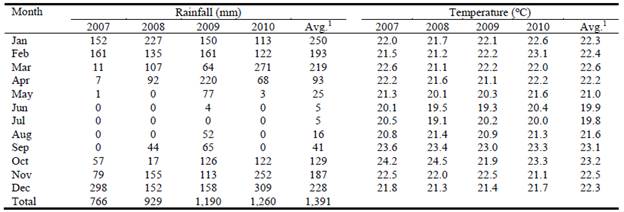
1Historical means (1974-2006)
Arachis spp. germplasm sources
The treatments were 10 genotypes of Arachis spp. (Table 2), consisting of 5 genotypes of Arachis pintoi Krapov. & W.C. Greg. (accessions 2, 4, 5, 6 and 8), 2 genotypes of Arachis repens Handro (accessions 1 and 7), 1 interspecific hybrid (accession 3) from a cross between A. pintoi cv. Amarillo and A. repens BRA-029220 and 2 cultivars of A. pintoi (cvv. Belmonte and BRS Mandobi). The genotypes and hybrid were drawn from the Arachis spp. germplasm collection of Embrapa Acre, located in Rio Branco, Acre State, Brazil. Cultivar Belmonte was collected in Bahia State, Brazil, and released in 1999 (Paganella and Valls 2002). Cultivar BRS Mandobi was obtained from a network of mass selection promoted by Embrapa in Brazil including the states Acre, Bahia and the Federal District (Assis et al. 2013).
Table 2 Identification, register and species of 10 Arachis spp. genotypes.

1Official germplasm accession number at Embrapa Recursos Genéticos e Biotecnologia.
Experimental design and sampling
The experimental design was a randomized complete block with 4 replications. Plots consisted of 4 rows of 2 m length with 0.5 m spacing between rows and 0.25 m between plants within rows, totaling an area of 4.0 m2. Vegetative material was struck in a greenhouse, using 200-mL plastic cups, and rooted plants were transplanted to plots on 4 December 2007. Plots were harvested on 31 March and 30 May 2008 to estimate dry matter yield (DMY) in the establishment year. Plants were cut at 0.05 m from the soil surface and forage mass was quantified in a 1 -m2 quadrat placed in the center of the plot. In subsequent years, plots were harvested every 42 days during the rainy season (November-April). The evaluation extended from Dec 2007 to Apr 2010 and harvests were categorized in 3 periods as described earlier and referred to herein as Year 1, Year 2 and Year 3. Harvests were made as follows: Year 1 - 31 March (1) and 30 May 2008 (2); Year 2 - 4 Dec 2008 (1), 15 Jan (2), 26 Feb (3), 9 Apr (4) and 21 May 2009 (5); and Year 3 - 20 Oct (1), 1 Dec 2009 (2), 12 Jan (3), 23 Feb (4) and 6 Apr 2010 (5).
A few days before each harvest (except for harvest 4 of Year 3), ground cover (GC) percentage of the Arachis spp. genotypes was estimated. This visual evaluation was performed by 2 observers who attributed scores to the plots in a range of 0-100%, and these scores were meaned.
Forage samples were dried in a forced-air oven at 55 oC for 72 h and then ground in a Wiley mill fitted with a sieve of 1 mm mesh for subsequent chemical analysis. Dry matter content, and crude protein (CP), neutral detergent fiber (NDF) and acid detergent fiber (ADF) concentrations were evaluated as described by Silva & Queiroz (2002). In vitro dry matter digestibility (DMD) was determined by the 2-stage method of Tilley & Terry (1963). All samples were analyzed, except those for harvest 1 of Year 3. The concentrations of macronutrients (Ca, Mg, P, K and S) of aerial plant parts were also determined according to Adler and Wilcox (1985). Forage samples from harvest 5 of Year 2 and from harvests 1 and 2 of Year 3 were not analyzed for macronutrient concentrations.
Statistical analyses
Dry matter yield data were analyzed in terms of annual forage accumulation considering all harvests during 3 years of evaluation. Nutritive value variables like DMD and CP, NDF, ADF and macronutrient concentrations were evaluated as annual mean values of forage samples analyzed. Agronomic and chemical analysis data were analyzed using Proc Mixed of SAS (Statistical Analysis System, version 9.2) with genotype, year and genotype x year as fixed effects, while block was considered a random effect. Year was tested as a fixed effect and a repeated measure because an effect on forage yield in a perennial experiment was expected. However, since genotype x year interactions were significant for most data (P<0.05), these data were analyzed by year using Proc GLM of SAS. Means for the effect of genotype were assessed by Least Significant Difference (LSD) by t test (P<0.05). Ground cover (GC) percentage for each harvest was described graphically with standard deviation bars.
Results
Dry matter yield (DMY) was affected by a genotype x year interaction (Table 3; P<0.0001). In the establishment year, DMY was lower than in Years 2 and 3 (mean yields of 4.2 vs. 8.4 and 8.7 t/ha, respectively). Arachis pintoi accessions 2 and 4 were quite productive throughout the evaluation (mean yields of 8.5 and 8.8 t DM/ha, respectively) along with cv. Belmonte (8.8 t DM/ha). Cultivar BRS Mandobi (5.7 t DM/ha) and A. pintoi accession 6 (5.6 t DM/ha) were the least productive genotypes throughout the study.
Ground cover was affected by a genotype x year interaction (Table 3; P<0.0001). In the establishment year GC of the various genotypes ranged from 83 to 96%. In the second and third years, larger differences emerged with ranges of 62-100% in Year 2 and 54-99% in Year 3. Throughout the evaluation, GC was greatest for A. pintoi accessions 2 and 4 and cv. Belmonte (Figure 1). Ground cover was maintained above 86% throughout by all genotypes, except for Mandobi and A. pintoi accessions 6 and 8, where cover had declined to about 60% or less by the end of the third year.
Table 3 Dry matter yield (DMY) and ground cover (GC) of 10 Arachis spp. genotypes in 3 years of evaluation (2008-2010) in Planaltina, Federal District, Brazil.
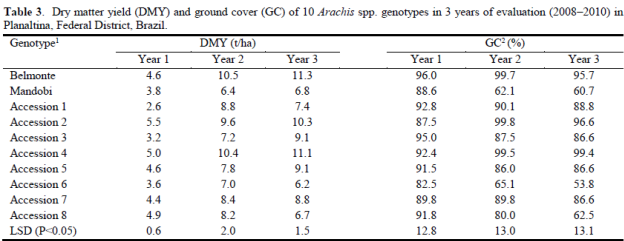
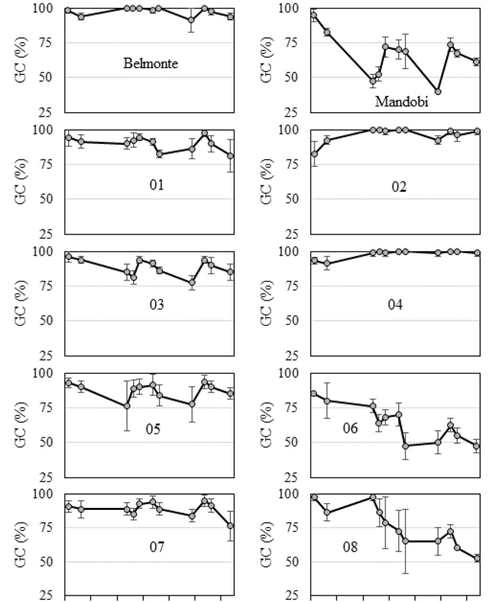
Figure 1 Ground cover (GC) percentage for 10 Arachis spp. genotypes in 3 years of evaluation (2008-2010) in Planaltina, Federal District, Brazil. Numbers 1 and 7 represent accessions of A. repens, numbers 2, 4, 5, 6 and 8 represent accessions of A. pintoi and number 3 represents an A. pintoi x A. repens hybrid. Small vertical bars represent 2 standard deviations. Each point plotted represents the mean of 4 replicates.
Dry matter digestibility (DMD) was affected by a genotype x year interaction (Table 4; P = 0.0118). Mean values were greater for the first 2 years of evaluation (610 and 614 g/kg, respectively) than for the third year (532 g/kg). In the first year, DMD of the hybrid accession 3 (678 g/kg) was 11% superior (P<0.05) to the mean of the remaining genotypes (610 g/kg), but there were no differences between genotypes in the second and third years (P>0.05).
There were significant genotype x year interactions for ADF (Table 4; P<0.0001) and NDF (Table 4; P = 0.0022) concentrations. The only consistency in ADF or NDF concentrations in the various genotypes throughout the study was that the hybrid (accession 3) had the lowest ADF values throughout.
Table 4 In vitro dry matter digestibility (DMD), and acid detergent fiber (ADF), neutral detergent fiber (NDF) and crude protein (CP) concentrations of 10 Arachis spp. genotypes in 3 years of evaluation (2008-2010) in Planaltina, Federal District, Brazil.
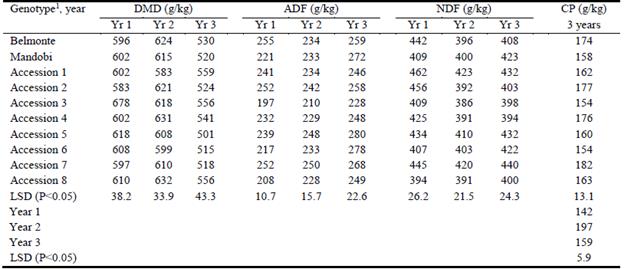
1Values presented are averages across 4 replications, 2 harvests in Year 1 (2008), 5 harvests in Year 2 (2008/09) and 4 harvests in Year 3 (2009/10).
Crude protein concentrations were affected by genotype (P = 0.0004) and year (P<0.0001). Arachis repens accession 7 and A. pintoi accessions 2 and 4 as well as cv. Belmonte had higher CP concentrations than all other genotypes (Table 4; P = 0.0004). In the first year of evaluation, mean CP concentration was 142 g/kg, increasing to 197 g/kg in Year 2, before decreasing to 159 g/kg in Year 3 (P<0.0001).
Concentrations of all macronutrients were affected by genotype x year interactions (P<0.05) (Table 5). However, the main difference that occurred in P concentrations was a marked drop from 2.1 and 2.3 g/kg in Years 1 and 2, respectively, to 1.3 g/kg in Year 3. A similar result was found for K concentration, where values dropped from 9.8 and 10.0 g/kg in Years 1 and 2 to 8.3 g/kg in Year 3. Magnesium values also declined from 4.7 and 3.9 g/kg in Years 1 and 2 to 1.5 g/kg in Year 3.
Table 5 Concentrations of macroelements (g/kg DM) in 10 Arachis spp. genotypes over 3 years of evaluation (2008-2010) in Planaltina, Federal District, Brazil.
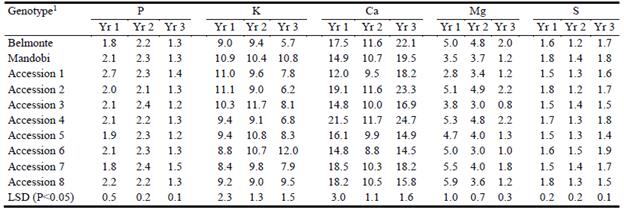
1Values presented are averages across 4 replications, 2 harvests in Year 1 (2008), 4 harvests in Year 2 (2008/09) and 3 harvests in Year 3 (2009/10).
Discussion
Although Arachis spp. yields were lower than those of introduced African C4 grasses in Brazil, they were similar to those of native perennial legumes from Brazilian savannas like Stylosanthes spp. (Ramos et al. 2010). In Acre State, cv. BRS Mandobi frequently reaches yields of 9-15 t DM/ha in the establishment year (Assis et al. 2013), much higher than the yields obtained in this study (Table 3). Even in Year 3, Mandobi failed to reach yields of that magnitude. On the other hand, cv. Belmonte performed at a higher level and appears better adapted to this environment than Mandobi (Ramos et al. 2010). Assis et al. (2008), in comparing Arachis spp. selected for the Amazonian region, observed that A. pintoi accessions 2 and 4 presented higher DMYs than other genotypes, including A. repens. In this same study, in the establishment year, accessions 2 and 4 yielded about 4 t DM/ha of forage while A. repens accessions 1 and 7 yielded about 3 t DM/ha. In Florida, USA, a collection of A. pintoi genotypes yielded 4.4 t DM/ha of forage in the first year of evaluation (Carvalho and Quesenberry 2012), similar to the DMYs reported in the first year of the current study. Genotypes of A. repens (accessions 1 and 7) showed lower DMYs than A. pintoi, which was to be expected for a Brazilian savanna environment (Pizarro and Rincón 1994). Considering the low productivity of most unfertilized grass pastures in Brazilian savannas, the mean DMYs displayed by the Arachis spp. could be considered satisfactory, particularly in the second and third years of evaluation.
Persistence of forage peanut in pastures is related to its capacity to cover the ground and thereby prevent the ingress of weeds that leads to pasture degradation. As a strategy to colonize an area, species from the botanical Arachis section Caulorrizhae, such as A. pintoi and A. repens, spread by stolons. This clonal reproduction is one of the most efficient mechanisms to ensure the persistence of forage legumes. In addition, the persistence of forage peanut is due to its high tolerance to trampling and defoliation, since it has a prostrate habit, with abundant and well protected growth points. However, the persistence and vigor of Arachis spp. in savannas can be short-lived due to irregular distribution of rainfall throughout the year, resulting in severe moisture stress. In 2008, rainfall during the first dry season (May-October) was very low (Table 1) resulting in decline in ground cover of most genotypes, especially Mandobi and accessions 5 and 6. Better rainfall distribution throughout 2009 failed to maintain maximum ground cover for most Arachis spp. genotypes during the dry season (Figure 1), because of low minimum temperatures in this period (<15 °C). However, the ability of these genotypes to maintain such high ground cover until the end of the study demonstrates their ability to survive in edaphoclimatic conditions of savannas. Nevertheless, their performance under grazing, when extra stresses would be experienced, still needs to be evaluated. The genetic variability existing among the germplasm evaluated would enable selection of more adapted genotypes and further gains through breeding. In Acre State, Valentim et al. (2003) observed that Belmonte reached 96% ground cover just 70 days after planting, higher than cv. Amarillo and other genotypes of A. pintoi and A. repens. For Amazonian conditions, Assis et al. (2008) observed that cvv. Belmonte and BRS Mandobi and accessions 2 and 4 were the best performing genotypes during the establishment phase in terms of DM yield and ground cover. Except for Mandobi, these results were similar to our findings under savanna conditions in the current study (Figure 1). In general, the most productive genotypes in the rainy season were those which achieved the highest values for ground cover.
As establishment of Arachis spp. is considered slow, the lesser productivity is continually associated with stand formation problems, even in humid areas (Valentim et al. 2003). In the current study, the slow initial development limited the number of cuts (2) in the first rainy season. This can require additional resources to assure an adequate initial ground cover and forage production (Carvalho and Quesenberry 2012), e.g. new germplasm and fertilization strategies. Otherwise, the expected benefits of the legume in the short term can be reduced (Pizarro and Rincón 1994). Because of its ability to produce acceptable seed yields, cv. BRS Mandobi was chosen from a selection network including many regions of Brazil. Assis et al. (2013) stated that about 18-21 months after planting, Mandobi produced 3 t/ha of pure seeds. This is an important characteristic, considering the restrictions on farmer adoption of Arachis spp. caused by the need for vegetative propagation, as can be observed for cv. Belmonte, which produces little seed. Although DM yield and persistence in savannas of some Arachis spp. might not be satisfactory, particularly for cv. BRS Mandobi, high seed production would allow for a lesser seed price, which could compensate for the need to have to replant the legume periodically. However, as a consequence of the geocarpic reproductive growth, lack of relevant seed harvesting technology could increase costs of seed production (Ferguson 1994).
In general, dry matter digestibility (DMD) of Arachis spp. is greater than that of other herbaceous tropical legumes, regardless of the season of the year (Gama et al. 2014). As it is strongly associated with forage quality and intake, DMD greatly affects animal performance at pasture. Dry matter digestibility of tropical grasses is usually low (<600 g/kg) compared with that of legumes. Despite differences in thickness of stems, A. repens genotypes 1 and 7 had similar DMD to that of A. pintoi genotypes, unlike hybrid accession 3 that had the greatest DMD in the first year (678 g/kg). In Florida, mean DMD of A. pintoi genotypes was 670 g/kg, ranging from 600 to 730 g/kg, similar to A. glabrata cvv. Florigraze and Arbrook (Carvalho and Quesenberry 2012), while in the Amazonian region, cv. BRS Mandobi showed DMD of 660 g/kg (Assis et al. 2013). Both studies showed greater mean DMD than the current study (613 g/kg in Years 1 and 2 and 532 g/kg in Year 3). In Brazilian savanna, Gama et al. (2014) observed that cv. Belmonte in mixed legume-grass pastures achieved DMD of 700 g/kg in the rainy season and 610 g/kg in the dry season, exceeding DMD of woody legumes like Leucaena leucocephala cv. Cunningham (590 g/kg) and Cratylia argentea (560 g/kg). Although selection and development of genotypes and hybrids are focused on other attributes, since the species has already high values of DMD, there is enough variability to improve the nutritive value of Arachis germplasm through hybridization.
Cultivar Belmonte and accessions 2 and 4, as the most productive genotypes in terms of DM yield, also presented greater crude protein (CP) concentrations, together with A. repens accession 7. There was, therefore, no evidence for a dilution effect of the N concentration in the most productive genotypes, possibly as a consequence of increased biological-N fixation over time. In Campo Grande, Mato Grosso do Sul State, cv. Belmonte showed CP concentrations of 190 g/kg in mixed grass-legume pastures throughout the year, slightly lower than those of the woody legumes Cratylia argentea and Leucaena spp., with 200 and 210 g CP/kg, respectively (Gama et al. 2014), but greater than reported in the current study for this same cultivar (174 g/kg). In a similar way, CP concentration for cv. BRS Mandobi in Acre State reached 230 g/kg (Assis et al. 2013), much greater than reported in the current study (158 g/kg). In Florida, mean CP concentration of a collection of A. pintoi genotypes was about 180 g/kg (Carvalho and Quesenberry 2012), while a collection of A. pintoi genotypes and cultivars (Belmonte and Alqueire 1) had mean CP concentration of 197 g/kg and A. repens genotypes showed 193 g CP/kg in Acre State (Valentim et al. 2003). These values are similar to those reported in the second year of the current study (197 g CP/kg). Crude protein concentrations ranging from 142 to 197 g/kg confirm the great potential of this germplasm to provide nutritious forage for livestock.
Nutritive value decay in the last year of the evaluation (Year 3), in terms of both DMD and CP, was also observed through the increased values of ADF, the fiber fraction associated with poor quality forage due to anti-nutritional lignin encrusted in cellulose. This increase in ADF can be related to the higher proportion of stems in the forage harvested and reduction in more nutritional leaves (assessed by visual observations). In Acre State, evaluations of BRS Mandobi presented approximately 276 g ADF/kg and 538 g NDF/kg (Assis et al. 2013), both greater than observed in the current study (242 and 411 g/kg, respectively). In a broad literature review of A. pintoi,Ramos et al. (2010) specified mean values of ADF and NDF of 236 and 403 g/kg, respectively, which are similar to the values obtained in the current study (241 and 415 g/kg, respectively).
According to Rao and Kerridge (1994), critical concentrations of P, K and S for A. pintoi (whole aerial biomass) are 2.3, 5.0 and 1.1 g/kg, respectively. The same authors considered a value of 18 g Ca/kg as adequate. Concentrations of K and S we measured are similar to the critical values, regardless of year, while concentrations of P and Ca were marginal at best. In a sandy soil in the humid region (~1,200 mm of annual rainfall) of Benin, West Africa, A. pintoi genotypes over 3 years achieved concentrations of 1.7, 5.3, 14.8, 10.1 and 1.2 g/kg of P, K, Ca, Mg and S, respectively (Adjolohoun et al. 2013). The occurrence of mineral deficiency in tropical pastures is very common and depends on not only forage species but also soil fertility, which is mostly poor in Brazilian savannas. In this study with limited fertilizer application, concentrations of macro-minerals were generally marginal to adequate, although the soil fertility of the experimental area was better than that of typical soils of Brazilian savannas. High values of K in whole plant tissue observed in this study indicate a significant amount of this nutrient being extracted from soil. Considering mean values of 10 g K/kg DM and 8.0 t DM/ha of yield, the extraction per year would be approximately 80 kg K/ha (equivalent to 96 kg K2O/ha). Irrespective of absolute values, the same genotypes that presented the highest forage yield also presented the highest values of Ca and Mg, particularly A. pintoi accessions 2 and 4.
Considering the benefits of Arachis spp. in grazing systems, it is important that breeding programs are continued to select genotypes for different purposes and localities. For Brazilian savannas it is also important to comprehend the potential role of Arachis spp. in the cattle production systems for this region. As opposed to the role of other legumes that complement the poor nutritive grass pastures during the dry season (e.g. Stylosanthes spp.), Arachis spp. have potential to intensify production systems during the rainy season, through a direct contribution to animal diets and also indirectly through promoting substantial recycling of nitrogen in the soil in mixed legume-grass pastures and increasing their longevity. While introduction, management and persistence of Arachis spp. are still relevant issues, seed production technology is one of the most important aspects that should be addressed in order to provide affordable and readily accessible seed for farmers. Under savanna conditions, in terms of forage production, nutritive value, ground cover and tissue macronutrient concentration, the new A. pintoi accessions 2 and 4 (accessions BRA-039799 and BRA-039187, respectively) were considered the most promising in this study. Their performance under grazing needs to be evaluated and steps made to improve seed production of these new materials.














